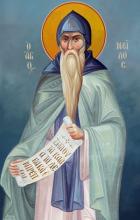12/25 ноября
 Venerable Nilus was the son of pious Orthodox parents, who lived in Morea, or the present-day Peloponnesus of Greece, in the eighteenth century. While still in his early years, he was orphaned; but he found a spiritual father in his uncle, Hieromonk Macarius. The nephew, possessing excellent natural gifts, showed rapid successes under his uncle's vigilant and heartfelt care for him. The time came, and the young Nilus, having received the monastic tonsure, was ordained a hierodeacon, and then also a hieromonk. The uncle and his nephew were one in soul in their field of service, but, having been inflamed by a desire for greater ascetic struggles, they left their fatherland and came to the Holy Mountain of Athos. While going around the local monasteries, scetes and hermitages, finally, they found a place called of old "the Holy Rocks". The place was extraordinarily remote, waterless and then still unsettled. In accordance with the monastery's typicon, they applied for a blessing to dwell in the wilderness. Having received it, the blessed toilers set about taming this land. The two souls, kindled by zeal for God, did not notice their merits and did not reckon their feats; soon, through indefatigable assiduity, a church rose up, consecrated in the name of Saints Peter and Athanasius and the Most Holy Theotokos. They themselves painted the church with icons, since they were expert iconographers.
Venerable Nilus was the son of pious Orthodox parents, who lived in Morea, or the present-day Peloponnesus of Greece, in the eighteenth century. While still in his early years, he was orphaned; but he found a spiritual father in his uncle, Hieromonk Macarius. The nephew, possessing excellent natural gifts, showed rapid successes under his uncle's vigilant and heartfelt care for him. The time came, and the young Nilus, having received the monastic tonsure, was ordained a hierodeacon, and then also a hieromonk. The uncle and his nephew were one in soul in their field of service, but, having been inflamed by a desire for greater ascetic struggles, they left their fatherland and came to the Holy Mountain of Athos. While going around the local monasteries, scetes and hermitages, finally, they found a place called of old "the Holy Rocks". The place was extraordinarily remote, waterless and then still unsettled. In accordance with the monastery's typicon, they applied for a blessing to dwell in the wilderness. Having received it, the blessed toilers set about taming this land. The two souls, kindled by zeal for God, did not notice their merits and did not reckon their feats; soon, through indefatigable assiduity, a church rose up, consecrated in the name of Saints Peter and Athanasius and the Most Holy Theotokos. They themselves painted the church with icons, since they were expert iconographers.
After the death of Macarius, the blessed Nilus, striving for complete solitude, found a place inaccessible, on account of its wildness and austereness, even to beasts. In the hollow of a cave, he consecrated an altar in the name of the Meeting of the Lord. Having settled here before the end of his life, he manfully endured every straitness and calamity, despising bodily repose and human consolation. What ascetic feats the cave that contained the ascetic saw! What struggles with demons and what victories over them it was a witness of, and what heavenly visions and choirs of angels, who appeared there for the consolation of the ascetic who was an equal of the Apostles, it was sanctified by! All this is known only to the Omniscient One. Having fled human glory during his life, Venerable Nilus did not want it after death either. Therefore, he made a sworn testament that no one dare open his remains. In accordance with his will, the saint was buried in a small cave below his cave; but the Lord, Who, according to His unlying word, places lamps upon lampstands, glorified His saint, so that He turned the virginal body, dedicated to God from youth, purified and refined by fasts, washed by tears and made fragrant by prayers, into myrrh and was well-pleased that it flow forth in manifestation to men even down the sheer cliff to the sea. The unheard of miracle of such an unprecedented flow of myrrh quickly became known to the whole Orthodox East.
